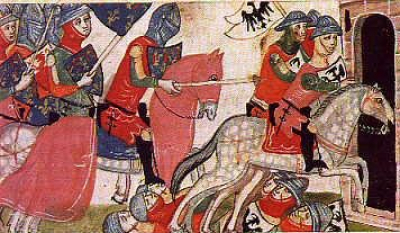Charles I (early 1226/1227 7 January 1285), commonly called Charles of Anjou, was a member of the royal Capetian dynasty and the founder of the second House of Anjou. He was Count of Provence (124685) and Forcalquier (124648, 125685) in the Holy Roman Empire, Count of Anjou and Maine (124685) in France; he was also King of Sicily (126685) and Prince of Achaea (127885). In 1272, he was proclaimed King of Albania; and in 1277 he purchased a claim to the Kingdom of Jerusalem.
The youngest son of Louis VIII of France and Blanche of Castile, Charles was destined for a Church career until the early 1240s. He acquired Provence and Forcalquier through his marriage to their heiress, Beatrice. His attempts to restore central authority brought him into conflict with his mother-in-law, Beatrice of Savoy, and the nobility. Charles received Anjou and Maine from his brother, Louis IX of France, in appanage. He accompanied Louis during the Seventh Crusade to Egypt. Shortly after he returned to Provence in 1250, Charles forced three wealthy autonomous citiesMarseilles, Arles and Avignonto acknowledge his suzerainty.
Charles supported Margaret II, Countess of Flanders and Hainaut, against her eldest son, John, in exchange for Hainaut in 1253. Two years later Louis IX persuaded him to renounce the county, but compensated him by instructing Margaret to pay him 160,000 marks. Charles forced the rebellious Provenal nobles and towns into submission and expanded his suzerainty over a dozen towns and lordships in the Kingdom of Arles. In 1263, after years of negotiations, he accepted the offer of the Holy See to seize the Kingdom of Sicily from the Hohenstaufens. This kingdom included, in addition to the island of Sicily, southern Italy to well north of Naples and was known as the Regno. Pope Urban IV declared a crusade against the incumbent Manfred of Sicily and assisted Charles in raising funds for the military campaign.
Charles was crowned king in Rome on 5 January 1266. He annihilated Manfred's army and occupied the Regno almost without resistance. His victory over Manfred's young nephew, Conradin, at the Battle of Tagliacozzo in 1268 strengthened his rule. In 1270 he took part in the Eighth Crusade organized by Louis IX, and forced the Hafsid Caliph of Tunis to pay a yearly tribute to him. Charles's victories secured his undisputed leadership among the Papacy's Italian partisans (known as Guelphs), but his influence on papal elections and his strong military presence in Italy disturbed the popes. They tried to channel his ambitions towards other territories and assisted him in acquiring claims to Achaea, Jerusalem and Arles through treaties. In 1281 Pope Martin IV authorised Charles to launch a crusade against the Byzantine Empire. Charles's ships were gathering at Messina, ready to begin the campaign when the Sicilian Vespers rebellion broke out on 30 March 1282 which put an end to Charles's rule on the island of Sicily. He was able to defend the mainland territories (or the Kingdom of Naples) with the support of France and the Holy See. Charles died while making preparations for an invasion of Sicily.
The Battle of Benevento was a major medieval battle fought on 26 February 1266, near Benevento in present-day Southern Italy, between the forces of Charles I of Anjou and those of King Manfred of Sicily. Manfred's defeat and death resulted in Charles' conquest of the Kingdom of Sicily, effectively ending the rule of the Hohenstaufen dynasty in the Italian Peninsula and marking the rise of the royal Capetian House of Anjou. The engagement was part of the conflict which pitted Guelphs against Ghibellines.

 English
English  español
español  français
français  português
português  русский
русский  العربية
العربية  简体中文
简体中文 
